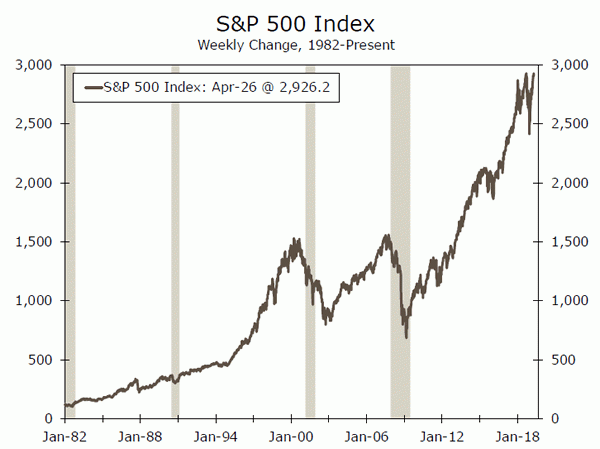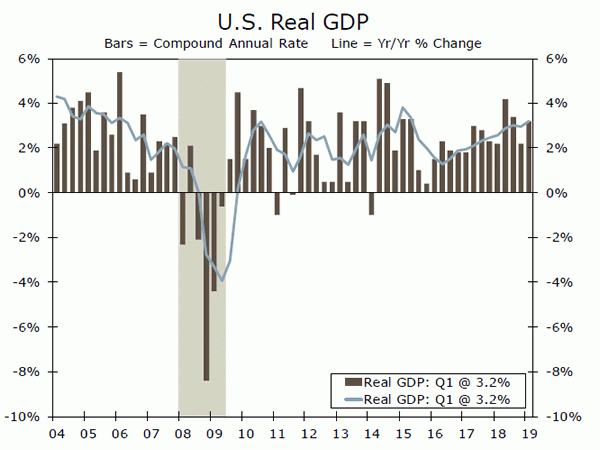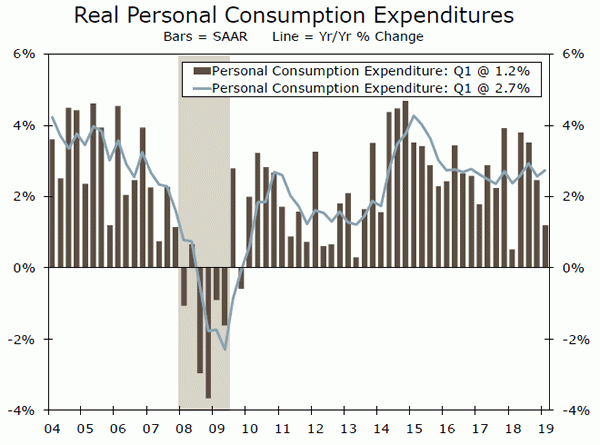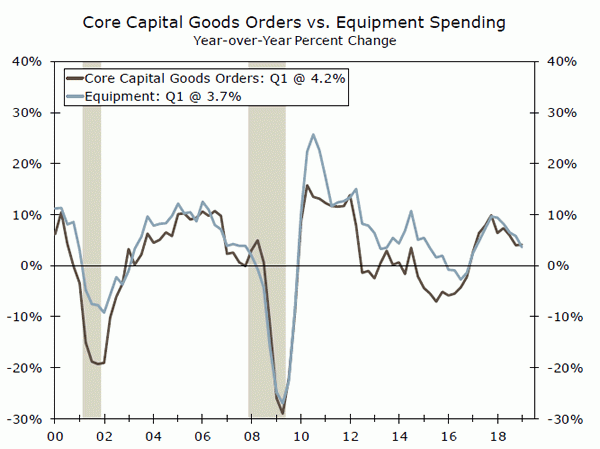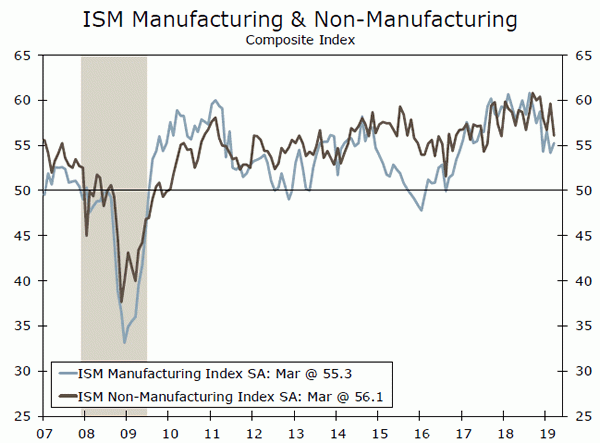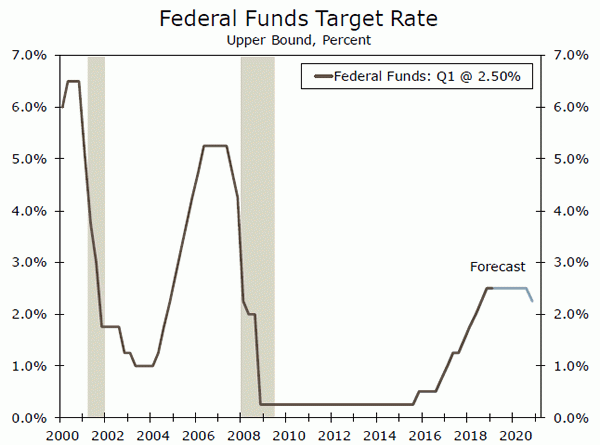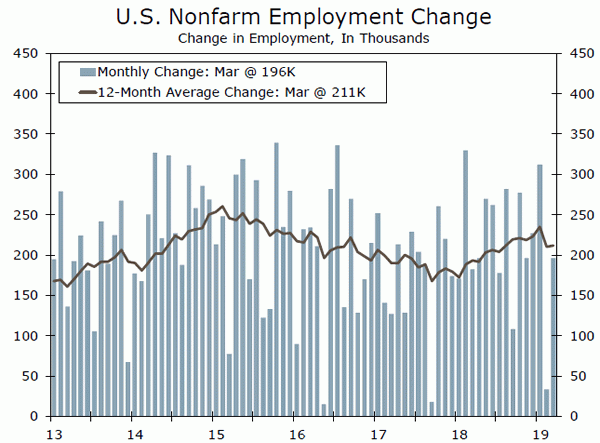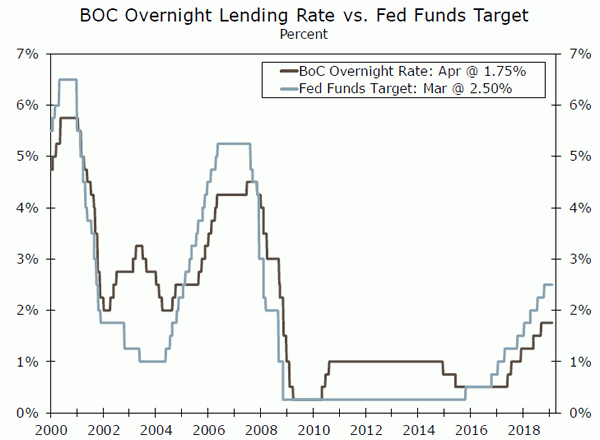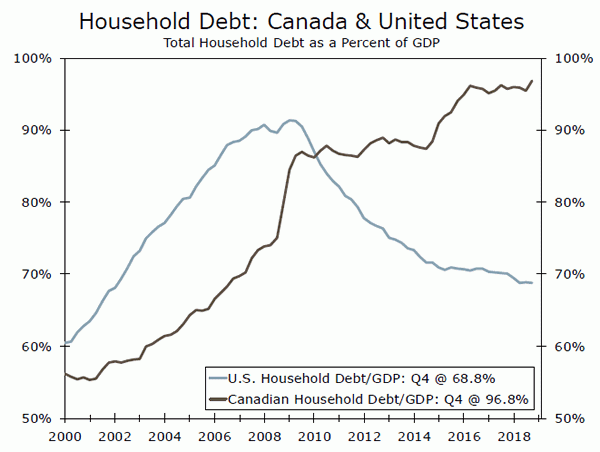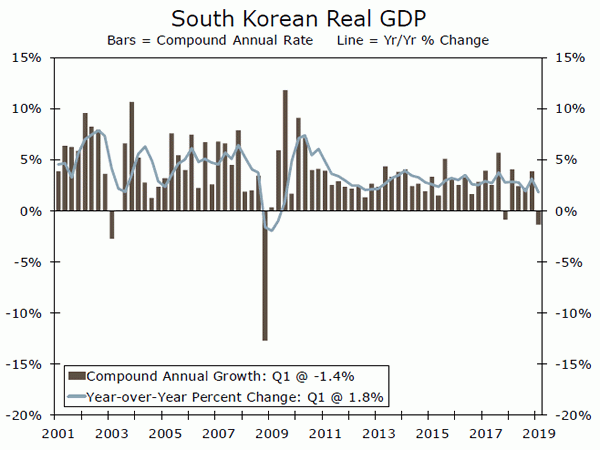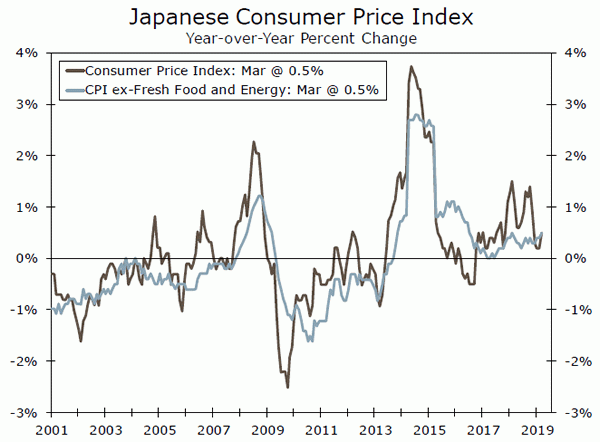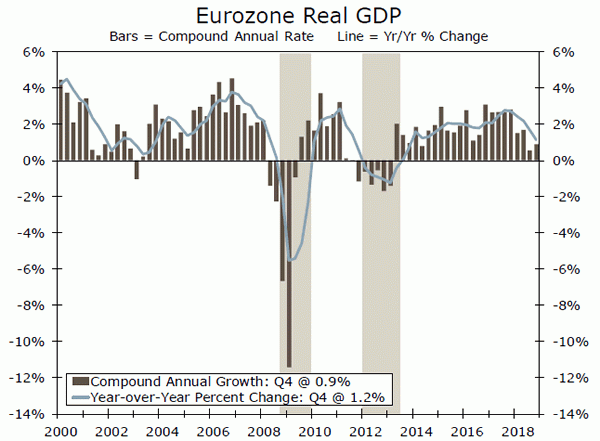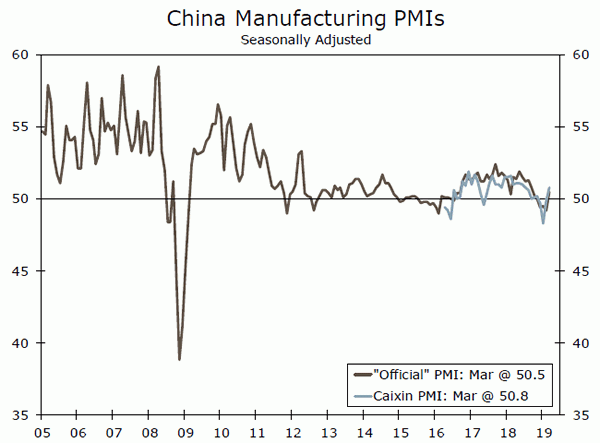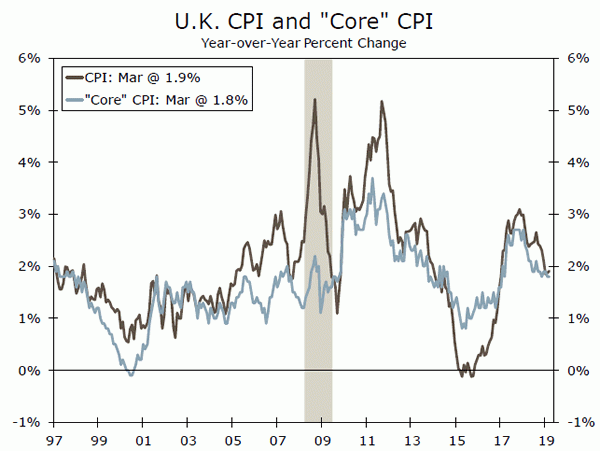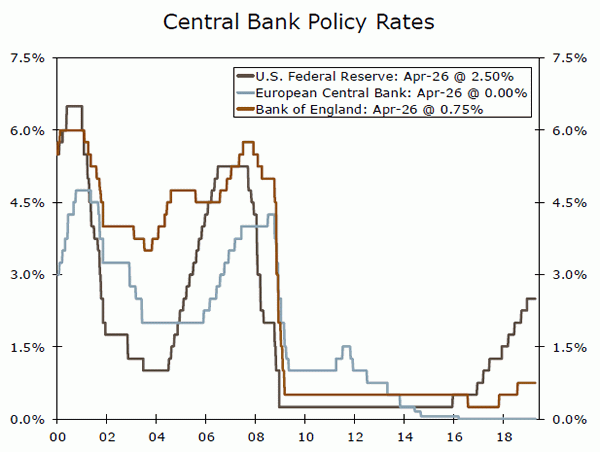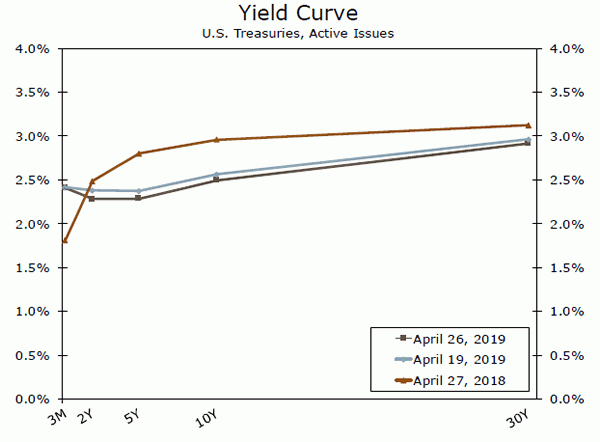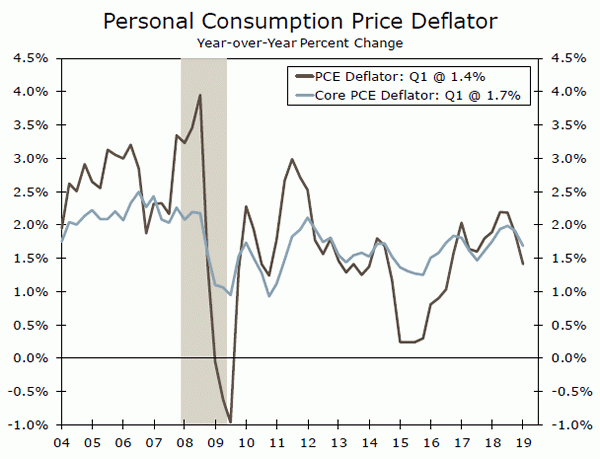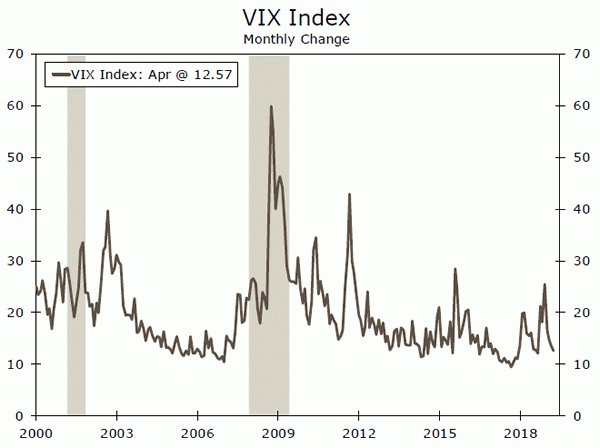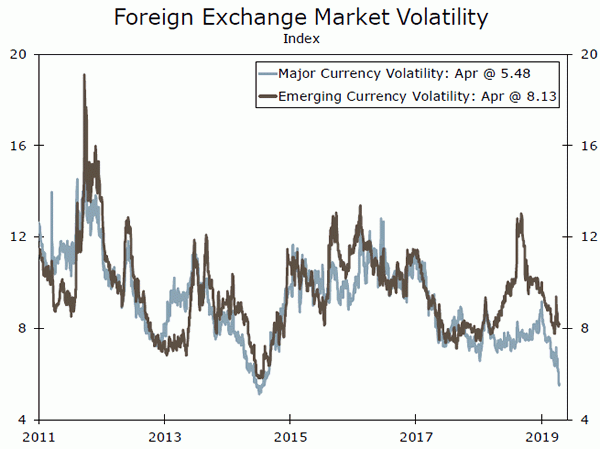U.S. Review
Data Reaffirm Fed Patience
- Economic data out the gate this week were broadly positive— U.S. real GDP grew at an annualized rate of 3.2% in Q1-2019, durable goods orders rebounded in March and the S&P 500 index reached its highest level on record.
- Despite the positive news this week, the U.S. economy continues to face some headwinds. The first quarter headline rate of growth was stronger than most analysts had expected, but underlying details of economic growth were not quite as strong as the headline growth rate suggests.
- This week’s data support our expectation for the Fed to refrain from raising rates for the foreseeable future.
Data Reaffirm Fed Patience
Economic data out the gate this week were broadly positive—U.S. real GDP grew at an annualized rate of 3.2% in Q1-2019, durable goods orders rebounded in March and the S&P 500 index reached its highest level on record. Despite the positive news this week, the U.S. economy continues to face some headwinds.
The first quarter headline rate of growth was stronger than most analysts had expected, and it represents a pick-up in growth relative to Q4. But, as we discussed in this morning’s GDP report, underlying details of economic growth were not quite as strong as the headline growth rate suggests.
First quarter growth was driven by a surge in inventories and a large contribution from net trade. Underlying consumption was weak, however, with final sales to private domestic purchases rising just 1.3%. That suggests at least some of the $128 billion build in inventories was unintentional. Inventory accumulation should fall back in coming quarters as a result, which would exert a headwind on the overall rate of GDP growth at that time. The one caveat here, however, is the plausible build from the Boeing’s 737 MAX aircraft, which while being produced but not delivered is expected to boost Q2 inventories. For additional detail of the economic impact from the 737 MAX, please see our special report.
Weaker consumer data in recent months sparked fear among analysts that the consumer had gone into hiding. We have long maintained the view that the weakness was a soft patch and not the start of a broad retrenchment in consumption. That said, as was expected, real personal consumption expenditures (PCE) slowed in the first quarter, rising only 1.2%. But, with the 1.6% surge in March retail sales and consumer sentiment data stabilizing, consumption ended the first quarter on a solid note, which provides some momentum headed into Q2. Fixed investment spending was up only 1.5% in the first quarter. But, investment too may accelerate in coming quarters, as durable goods orders data for March suggest capital spending may be picking up.
Net exports provided a sizable boost, adding 1.0 percentage point to the overall rate of GDP growth in Q1—which is among the largest positive contributions this component has made this cycle. Exports grew a modest 3.7%, but imports fell 3.7%. As domestic demand strengthens, real imports are expected to rebound in coming quarters, but this will exert a drag on growth.
Although the economy may not have been as strong in Q1 as the headline GDP growth rate suggests, the economy is not in danger of stalling anytime soon. That said, this week’s data support our expectation for the Fed to refrain from raising rates for the foreseeable future. As we have highlighted, the underlying details were not as strong as the headline rate of GDP growth suggests. Further, the core PCE deflator rose at an annualized rate of just 1.3% in the first quarter. With the Fed’s preferred measure of consumer price inflation remaining below its objective of 2%, it seems likely that the FOMC will be happy to remain on the sideline watching the incoming data. For further reading of our expectations regarding next week’s FOMC meeting, please see the Interest Rate Watch section on page 6.
U.S. Outlook
ISM Manufacturing • Wednesday
Manufacturing activity has slowed in recent months amid trade uncertainty and cooler global growth. With a trade deal with China looking more likely and the growth abroad firming up a bit, U.S. factory activity looks to be stabilizing. Purchasing managers’ indices (PMIs) from the regional Federal Reserve Banks were little changed on balance in April, while the preliminary Markit manufacturing PMI was unchanged. As a result, we look for the ISM to come in close in line with its April print at 55.1.
An upside surprise would signal to the FOMC that the headwinds to the outlook from the trade and global-growth environment are easing, and could spur speculation that the FOMC’s next move will be tightening. The ISM non-manufacturing index, released on Friday, is a more meaningful gauge of the overall U.S. backdrop, however. We expect that index to improve to 57.3.
Previous: 55.3 Wells Fargo: 55.1 Consensus: 55.0
FOMC • Wednesday
Next week’s FOMC meeting will not be followed up by fresh economic projections, but it will be concluded by a press conference with Chair Powell. Closely watched in the statement will be whether the FOMC continues to pledge patience in determining future adjustments to policy. Removing “patient” could give the FOMC more flexibility at future meetings. However, if not carefully communicated, it could be construed that the FOMC is gearing up to hike again given an improvement in recent data, which could lead to a tightening in financial conditions.
Of interest in the press conference will be the way in which conditions would need to change for the FOMC to alter its policy stance either direction given current expectations for it to remain on hold. We view inflation as the key condition to get the FOMC tightening again, but a cut would also depend on renewed tightening in financial conditions and growth slowing below trend.
Previous: 2.25-2.50% Wells Fargo: 2.25-2.50% Consensus: 2.25-2.50%
Employment • Friday
After wild swings to start the quarter, payroll growth settled down in March with employers adding 196K jobs. Hiring of temporary workers has slowed the past few months and points to the overall trend in job growth remaining slower than in 2018. Recent PMI readings of hiring also point to a slower pace compared to last year, but suggest a pickup from the first quarter’s lull. The same goes for a new cycle low in jobless claims in April, although the drop was likely exaggerated by the late timing of Easter this year.
Upside or downside, if payrolls come in well-wide of consensus, we expect it to sway sentiment about which direction the FOMC’s next move is likely to be. Inflation remains the biggest question for the FOMC in our view, however, which will keep average hourly earnings (AHE) in focus. We expect AHE to increase 0.2% in April, held down in part by calendar quirks, while the unemployment rate will likely hold at 3.8%.
Previous: 196K Wells Fargo: 200K Consensus: 181K
Global Review
Global Growth Concerns Continue to Linger
- At its meeting this past week, monetary policymakers in Canada left their main policy rate unchanged and dropped a reference to future rate increases that had been in every statement since the end of 2017.
- Real GDP growth in South Korea unexpectedly contracted 1.4% on a sequential, annualized basis in Q1-2019, bringing the year-over-year pace below 2% for the first time since 2009.
- The Bank of Japan rounded out the week by reaffirming its extraordinarily easy stance of monetary policy and signaling that the current policy of holding both short and long-term rates near zero would continue through at least the spring of 2020.
Global Growth Concerns Continue to Linger
Like the Federal Reserve, the Bank of Canada (BoC) has been a developed economy central bank that has succeeded in bringing its main policy rate up in recent years (see chart on front page). Strong employment growth, a steady closing of the output gap and core inflation that remained in the ballpark of 2% helped the BoC chart a course with more tightening than most.
At its meeting this past week, however, the BoC seemed to bring its language in-line with the dovish mindset that has taken hold at most major central banks of late. Monetary policymakers in Canada left their main policy rate unchanged and dropped a reference to future rate increases that had been in every statement since the end of 2017. The Bank also cut its growth forecast for 2019 by half a percentage point, to 1.2% from 1.7%.
The headwinds in Canada have been strong recently. In its statement, the BoC acknowledged that global economic growth had slowed by more than the Bank forecast in January. Oil’s swoon over the winter has also been a hurdle, as has continued trade uncertainty, especially as it relates to NAFTA and its possible heir apparent, the USMCA.
Making matters worse, Canadian households appear to finally be feeling the weight of their significant debt burdens. Unlike households in the United States, households in Canada continued to see leverage as a share of the economy rise during this expansion (top chart). Much of the debt growth occurred as a result of a frothy housing market, but of late home price appreciation has slowed dramatically. Both we and the BoC believe growth should stabilize around 1.5-2.0% later this year, but given the challenges it looks increasingly like any additional policy tightening is a ways away.
Real GDP growth in South Korea unexpectedly contracted 1.4% on a sequential annualized basis in Q1-2019, bringing the year-over-year pace below 2% for the first time since 2009 (middle chart). South Korea is a country heavily integrated into global trade, particularly to China: total exports are about 44% of South Korean GDP, and nearly 25% of Korean exports are to China. Export volumes fell 2.6% on a sequential basis in Q1, steeper than the 1.5% fall in Q4-2018. Investment spending was also soft. Gross fixed capital formation declined 8.4% year-over-year, accelerating the 3.8% dip seen in Q4-2018. Better economic data out of China and the United States, Korea’s second largest trading partner, bode well for the second half outlook. But, the recent weakness in South Korea could be perceived as another sign that the global economy is not out of the woods yet.
The Bank of Japan (BoJ) rounded out the week by reaffirming its extraordinarily easy stance of monetary policy. The BoJ added a new forward guidance element to its policy statement, signaling that the current policy of holding short and long-term rates near zero would continue through at least the spring of 2020. With policy options more limited in Japan than perhaps any other developed economy, it appears the BoJ is turning to forward guidance to provide additional stimulus and boost inflation, which remains mired below 2% (bottom chart).
Global Outlook
Eurozone GDP • Tuesday
Economic growth in the Eurozone has slowed markedly. Real GDP growth was just 1.2% year-over-year in Q4-2018, the slowest pace since Q4-2013. GDP data for the first quarter will be released next Tuesday, and the monthly indicator data point to some stabilization, but not a full turnaround. Retail sales have rebounded solidly in the first two months of the first quarter after December’s inexplicably weak reading, and the services PMI appears to have found a floor in the 51-52 range. Though still negative on a year-ago basis, industrial production growth has also been a bit better of late.
Still, it appears economic growth is likely to come in around a relatively weak 1% pace, both on a year-over-year basis and as a compound annual growth rate for the quarter. It will likely take more than a stabilization around current growth rates to convince policymakers at the European Central Bank that the next move will be for tightening monetary policy rather than additional stimulus.
Previous: 0.2% Consensus: 0.3% (Quarter-over-Quarter, Not Annualized)
China PMIs • Monday/Wednesday
In late March and early April, stronger PMI readings out of China helped assuage some concerns about a significant slowdown in the country to start 2019. “Hard” data reported a couple weeks later showed real GDP growth was steady at 6.4% in Q1-2019, suggesting the government’s stimulus efforts have helped prevent a sharp slowdown in the near term.
We have believed for some time that Chinese policymakers would do what it takes to keep economic growth from slowing too sharply. Even with the measures taken thus far, however, the data are still far from robust. Both the “official” and the private Caixin PMIs for manufacturing are only a bit above the key 50 level. Some additional improvement in the data would be welcome, but for both structural and trade-related reasons we expect Chinese economic growth to continue slowing in the quarters ahead, just at a relatively controlled pace.
Previous: 50.5 (Mfg., “Official”), 50.8 (Mfg., Caixin) Consensus: 50.6 (Mfg., “Official”), 51.0 (Mfg., Caixin)
Bank of England Meeting • Thursday
The Bank of England (BoE) has kept monetary policy on hold for an extended period of time while awaiting the resolution of the Brexit knot, originally due to clear a major hurdle on March 29. Two extensions later, and the U.K. now has until October 31 to sort out how to proceed with leaving the European Union.
This likely leaves monetary policymakers still stuck in limbo. The Bank of England has appeared poised to hike rates for months but has been held back by the uncertainty related to Brexit. The output gap appears mostly closed in the United Kingdom, and inflation is right around the 2% target. The BoE also noted in its last statement that, with wage growth around 3.5% and continued weakness in productivity growth, growth in unit wage costs has risen. With so much uncertainty still at play, however, we believe the BoE will probably keep its main policy rate on hold until next year.
Previous: 0.75% Wells Fargo: 0.75% Consensus: 0.75%
Point of View
Interest Rate Watch
Rates Are Unmoved By Stronger GDP
The first quarter’s surprisingly robust 3.2% annualized real GDP growth was not nearly as strong as the headline indicated. Growth was bolstered by an abrupt turnaround in international trade and surge in inventories, neither of which is likely to continue in the second quarter. Top line growth also benefitted from a surge in state and local government spending, which was largely highway and road work delayed during the unusually rainy fall months. Final sales to private domestic purchasers, which is a more accurate measure of final demand in the economy, rose at just a 1.3% pace.
The paltry gain in final domestic demand explains why inflationary pressures cooled during the first quarter, even though headline growth appeared to have surged. The PCE deflator slowed to just 1.4% year-over-year during the first quarter. At this point of the expansion, the financial markets and the Fed are more concerned about where the economy and inflation are headed than where they have been.
The underlying data suggests economic growth is slowing and inflation is decelerating, which at a minimum should keep the Fed on hold. Treasury yields declined following the GDP release. We still see the Fed’s next move as a rate cut but not until the fourth quarter of 2020.
We expect to see the Fed focus a great deal on the deceleration in core inflation at next week’s FOMC meeting. The year-over-year change in the core PCE deflator has slowed from 2.2% a year ago to just 1.3% currently, even though real GDP growth has risen 3.2% over this time period and the unemployment rate has fallen 0.2 percentage points to 3.8%. Inflation expectations also remain contained.
Slower global growth and heightened uncertainty surrounding trade negotiations with China and Europe are also top of mind for the financial markets and the Fed. Slower global growth appears to be weighing on the U.S. manufacturing sector, although the downside risks appear to have eased more recently. Moreover, data on orders, production and employment have, so far, proved surprisingly resilient.
Credit Market Insights
The Fed and Financial Markets
The S&P 500 rose to an all-time high this past Tuesday, as financial markets have enjoyed one of the best starts to the year in decades. The S&P is up nearly 25% since bottoming out at the end of December. Investment grade credit spreads have fallen 50 bps since December back to the levels averaged over most of 2018, while high yield credit spreads have fallen over 150 bps, remaining slightly above their 2018 average. Financial markets have been more than happy to embrace the FOMC’s monetary policy pivot, after its recognition at its January meeting of the “tightening of financial conditions and the associated downside risks to the U.S. economic outlook that had emerged since the fall.” Fast forward to the March meeting, and the FOMC explicitly attributed the financial market rebound to the “perceived shift in the FOMC’s approach to policy following communications stressing that the Committee would be patient.” With the next FOMC meeting on Tuesday—one week after the S&P reached a record high—will it deem a further pause appropriate, or has the major impetus for its pivot sufficiently dissipated? We think it was not the financial market sell-off per se that drove the FOMC to pause, but rather the fact that the markets were signaling their displeasure with perceived insufficient policy flexibility. Taking this lesson to heart, the FOMC is now facing persistently sub-2% inflation and unresolved global risks that together justify further patience—despite investors’ rediscovered exuberance.
Topic of the Week
Where Has All the Volatility Gone?
Back in December, financial markets encountered significant turbulence. However, volatility has receded markedly so far this year. For example, the VIX index, which measures volatility in the stock market, has trended significantly lower since the beginning of the year (top chart). Volatility indices in the foreign exchange market have also receded (bottom chart), and the yield on the 10-year Treasury security has fluctuated in a narrow 20 bps range in recent weeks. What’s causing the drop in financial market volatility?
For starters, central banks have turned dovish this year. The Federal Reserve contributed to the spike in volatility in December when the FOMC continued to signal that it likely would raise rates significantly further this year. However, most FOMC members now believe that no further tightening will be needed in 2019, and the European Central Bank recently pushed back its projected date of “lift off.” The Bank of England likely will be on hold as long as uncertainty about Brexit continues to linger. Trade tensions among some of the largest economies of the world have also died down this year.
We have no idea how long financial market volatility will remain suppressed. But there are a number of potential catalysts that could trigger a return of volatility. First, the Fed could potentially turn less dovish. If economic data in coming months come in stronger than expected and/or if inflation moves markedly higher, then FOMC members may become less sanguine about the outlook for monetary policy. Second, the Commerce Department submitted a report to President Trump on February 17 on whether auto imports constitute a national security threat to the United States. The president needs to decide by May 18 what action, if any, the administration will take. If President Trump decides to impose tariffs on auto imports, American trading partners (e.g., Germany and Japan) could retaliate with tariffs on American goods. A trade war with those countries, should one ensue, would surely lead to higher volatility in financial markets. Stay tuned.




